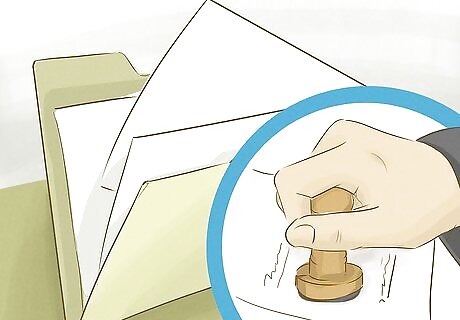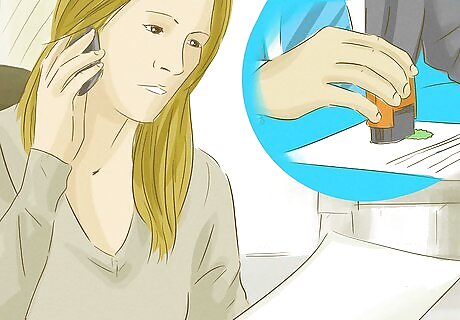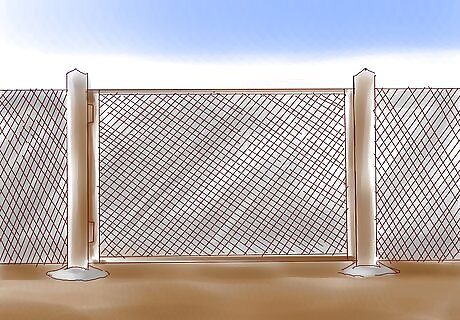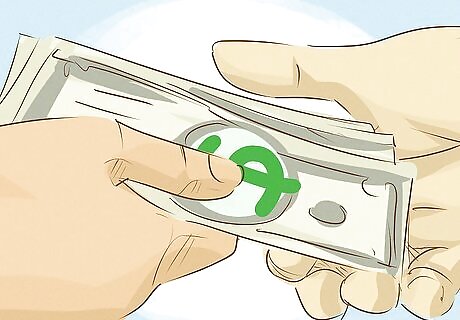
views
Terminating an Easement Through Expiration

Assess the current easement. If your easement includes a provision stating that it will be terminated on a certain date or at the occurrence of a certain event, then your easement will terminate when that date comes or when that event occurs. Look through your easement documents for one of these provisions and understand how the provisions works. For example: Your easement might state: "This easement will terminate on June 5, 2015." If this provision exists, your easement will cease to exist on June 5, 2015. In order to be effective, this date must be certain and explicit and should not be open ended (e.g., "this easement will terminate sometime in the next five years"). Your easement might also state: "This easement will terminate when Party Y no longer needs to use the access road to haul lumber from their property." In this situation, your easement will terminate when Party Y no longer uses the access road to haul lumber.

Notify the other party. Once you have identified and understand your easement's termination provision, you should notify the other landowner of its termination. This is important as they may think your easement is still effective and may continue to use it. While you are not obligated to notify the other party to the easement in this situation, it will make your termination process smoother and more beneficial to both parties of the easement. Also, notifying the other landowner will give you an opportunity to discuss the termination provision and will allow you to agree on the easement's termination. In some instances, you or the other party may want to extend the life of an easement and notifying the other party will allow you to have this conversation. If this is the case, negotiate with the other party and come to an acceptable agreement.

Record your easement's termination. Once you and the other party are in agreement that you are going to terminate the easement by expiration, get this agreement in writing and record an easement termination document with the applicable registry of deeds. Because a lot of easements are recorded interests in real property, if you do not record its termination, the easement may still appear on a title search and may affect the land's value and potential uses. You can usually find an easement termination document by going to your county's court website or by calling your county's clerk of courts and asking for help. When you look on the website or call the clerk of courts, you will be looking for, or asking for, an easement termination template you can use to record a terminated easement. To record something, you will have to take your real estate document terminating the easement to your recorder's office and pay a fee. The document will then be given a number and a time-stamp indicating when the document was recorded. It is then filed with any other documents that have been recorded on that specific piece of property. Recording documents provides a traceable chain of title to a specific piece of property, including any other interests that may exist on that piece of property (e.g., mortgages, liens, and easements), and it is therefore incredibly important that you record documents quickly and accurately. Because of the importance of recording, you should consult an experienced real estate attorney whenever you are going to record something. He or she will be able to help you through the process and will ensure you accomplish the goals you set out to accomplish.
Terminating an Easement Through Release

Speak with the other party. An easement is terminated by release when the dominant estate (landowner that is benefited by the easement - the one using the easement) grants a release of its easement rights to the servient estate (landowner that is burdened by the easement - the one allowing someone else to use their land). This method of termination through written agreement is the most effective long term and will cause the least controversy in the future. If you are interested in terminating an easement through a release, and you are the dominant estate holder, begin by contacting the servient estate holder and telling them you are going to release your easement rights. In this situation, the other party has no say in what happens because you are simply stating that you are no longer going to enforce or use the easement. If you are interested in terminating an easement through a release, and you are the servient estate holder, you will have to ask the other party to release their rights under the easement. Here, you may have an opportunity to negotiate a deal but may have to provide something of value in order to have the other party release their rights. For example, you may have to provide financial compensation, or maybe another easement, in order for the other party to agree to release their rights under the easement. However, it is not unheard of for another party to simply agree to release their rights, particularly if they do not use the easement a lot and if it does not burden them to release their rights.

Obtain your agreement in writing. Once you agree to a release, the termination agreement MUST be in writing. Also, in the event there are multiple dominant estate holders (e.g., a parcel of land is owned by three separate individuals), every dominant estate holder must agree to the release. When you draft this document, be sure you clearly identify the properties involved, the rights being released, and all the parties to the agreement.

Record your easement's termination. Once you and the other party are in agreement that you are going to terminate the easement by release, get this agreement in writing and record an easement termination document with the applicable registry of deeds. Because a lot of easements are recorded interests in real property, if you do not record its termination, the easement may still appear on a title search and may affect the land's value and potential uses. You can usually find an easement termination document by going to your county's court website or by calling your county's clerk of courts and asking for help. When you look on the website or call the clerk of courts, you will be looking for, or asking for, an easement termination template you can use to record a terminated easement. To record something, you will have to take your real estate document terminating the easement to your recorder's office and pay a fee. The document will then be given a number and a time-stamp indicating when the document was recorded. It is then filed with any other documents that have been recorded on that specific piece of property. Recording documents provides a traceable chain of title to a specific piece of property, including any other interests that may exist on that piece of property (e.g., mortgages, liens, and easements), and it is therefore incredibly important that you record documents quickly and accurately. Because of the importance of recording, you should consult an experienced real estate attorney whenever you are going to record something. He or she will be able to help you through the process and will ensure you accomplish the goals you set out to accomplish.
Terminating an Easement Through Abandonment or Prescription

Stop using the easement or block use of the easement. Depending on whether you are the dominant estate holder or the servient estate holder, you will have the option to terminate an easement by either abandonment or prescription. Depending on which party you are, the first step in terminating an easement in these manners is to either stop using the easement or to block use of the easement. If you are the dominant estate holder, you can terminate an easement through abandonment. The first step in terminating an easement through abandonment is to cease to use the easement at all. This means you cannot do what it is the easement allows you to do. For example, if you have an easement that allows you to drive over someone's land to get to your own, and you want to terminate the easement through abandonment, you must cease to drive across the other person's land in order to get to your own. If you are the servient estate holder, you can terminate an easement through prescription. The first step in terminating an easement through prescription is to block the other party's use of the easement. For example, if you have allowed another landowner to drive across your driveway in order to get to their land, you could put up a fence across your driveway and not allow the other party to get through.

Act in a way that shows you are trying to terminate the easement. Once you have either stopped using the easement or blocked the use of an easement, depending on which party you are, you will have to either show an intent to relinquish your easement rights or you will have to block the other party's use of the easement in an open manner. If you do this, the easement will be terminated. If you are the dominant estate holder, while you are not using the easement, you must also show some intent to relinquish your rights under the easement. For example, apart from not using the easement, you may also tell the other land owner that you do not need the easement anymore. If you are the servient estate holder, apart from blocking the other party's use of the easement, you must also do so openly. This means you must block use in an obvious way, so that if the other land owner were to inspect the land, he or she would notice and become aware of your blocking. For example, putting a locked fence in front of your driveway is likely considered open. However, putting a small log that can easily be removed in front of your driveway may not meet this requirement.

Record your easement's termination. Once you fulfill the requirements of terminating an easement by abandonment or prescription, record an easement termination document with the applicable registry of deeds. Because a lot of easements are recorded interests in real property, if you do not record its termination, the easement may still appear on a title search and may affect the land's value and potential uses. You can usually find an easement termination document by going to your county's court website or by calling your county's clerk of courts and asking for help. When you look on the website or call the clerk of courts, you will be looking for, or asking for, an easement termination template you can use to record a terminated easement. To record something, you will have to take your real estate document terminating the easement to your recorder's office and pay a fee. The document will then be given a number and a time-stamp indicating when the document was recorded. It is then filed with any other documents that have been recorded on that specific piece of property. Recording documents provides a traceable chain of title to a specific piece of property, including any other interests that may exist on that piece of property (e.g., mortgages, liens, and easements), and it is therefore incredibly important that you record documents quickly and accurately. Because of the importance of recording, you should consult an experienced real estate attorney whenever you are going to record something. He or she will be able to help you through the process and will ensure you accomplish the goals you set out to accomplish.
Terminating an Easement Through Merger

Negotiate with the other party. When an easement is terminated by a merger, the dominant and servient estates come under common ownership. This is the case because an owner cannot have an easement over his or her own land. In order to start this process, contact the other parties involved and negotiate with them to purchase their land. Terminating an easement in this manner is uncommon unless you or the other landowners were already planning on selling their land. It is uncommon because you would normally not purchase a parcel of land simply to terminate an easement. As you can see form the other methods, there are other ways to terminate an easement that do not involve such a drastic input of money and/or stress.

Purchase all other parcels of land that are involved in the easement. If all parties agree that having you purchase all the other parcels of land is in the best interest of everyone, you will want to go through the process of purchasing their real estate. The process of purchasing real estate includes: Making an offer and writing up a contract. You will first need to make an acceptable offer to all other interested land owners and get your agreement to purchase their land in writing. The contract will be legally binding, although there are usually contingencies allowing you to back out in case some of the other steps do not go as planned. Disclosure review. After you have signed the contract, the seller(s) will provide you with a disclosure statement, which is a document that discloses any number of things, including flaws with the property and a preliminary title report. If you see something in your review concerns you, you may be able to back out of the deal. Inspections. As part of the real estate contract, you usually have the right to inspect the home for yourself to make sure everything looks good. Closing. Finally, after you have done all of your due diligence, you will sign your closing papers, pay for the property, and the process will be complete.

Always record your easement's termination. Once you or the other party hold title to both parcels of land, record your real estate purchase as well as an easement termination document with the applicable registry of deeds. Because a lot of easements are recorded interests in real property, if you do not record its termination, the easement may still appear on a title search and may affect the land's value and potential uses. You can usually find an easement termination document by going to your county's court website or by calling your county's clerk of courts and asking for help. When you look on the website or call the clerk of courts, you will be looking for, or asking for, an easement termination template you can use to record a terminated easement. To record something, you will have to take your real estate document terminating the easement to your recorder's office and pay a fee. The document will then be given a number and a time-stamp indicating when the document was recorded. It is then filed with any other documents that have been recorded on that specific piece of property. Recording documents provides a traceable chain of title to a specific piece of property, including any other interests that may exist on that piece of property (e.g., mortgages, liens, and easements), and it is therefore incredibly important that you record documents quickly and accurately. Because of the importance of recording, you should consult an experienced real estate attorney whenever you are going to record something. He or she will be able to help you through the process and will ensure you accomplish the goals you set out to accomplish.


















Comments
0 comment